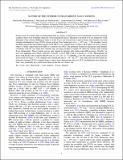| dc.contributor.author | Wiktorowicz, Grzegorz | |
| dc.contributor.author | Belczynski, Krzysztof | |
| dc.contributor.author | Sobolewska, Malgorzata | |
| dc.contributor.author | Sadowski, Aleksander B | |
| dc.date.accessioned | 2015-11-24T20:44:52Z | |
| dc.date.available | 2015-11-24T20:44:52Z | |
| dc.date.issued | 2015-08 | |
| dc.date.submitted | 2015-03 | |
| dc.identifier.issn | 1538-4357 | |
| dc.identifier.issn | 0004-637X | |
| dc.identifier.uri | http://hdl.handle.net/1721.1/100049 | |
| dc.description.abstract | In this proof-of-concept study we demonstrate that in a binary system mass can be transferred toward an accreting compact object at an extremely high rate. If the transferred mass is efficiently converted to X-ray luminosity (with disregard of the classical Eddington limit) or if the X-rays are focused into a narrow beam, then binaries can form extreme ultraluminous X-ray (ULX) sources with an X-ray luminosity of L[subscript X] ≳ 10[superscript 42] erg s[superscript -1]. For example, Lasota and King argued that the brightest known ULX (HLX-1) is a regular binary system with a rather low-mass compact object (a stellar-origin black hole (BH) or a neutron star (NS)). The predicted formation efficiencies and lifetimes of binaries with the very high mass transfer rates are large enough to explain all observed systems with extreme X-ray luminosities. These systems are not only limited to binaries with stellar-origin BH accretors. Notably, we have also identified such objects with NSs. Typically, a 10 M[subscript ʘ] BH is fed by a massive (~10 M[subscript ʘ]) Hertzsprung gap donor with Roche lobe overflow (RLOF) rate of ~10[superscript -3] M[subscript ʘ] yr[superscript -1] (≈2600[. over M][subscript Edd]). For NS systems the typical donors are evolved low-mass (~2 M[subscript ʘ]) helium stars with RLOF rate of ~10[superscript -2] MM[subscript ʘ] yr[superscript -1]. Our study does not prove that any particular extreme ULX is a regular binary system, but it demonstrates that any ULX, including the most luminous ones, may potentially be a short-lived phase in the life of a binary star. | en_US |
| dc.language.iso | en_US | |
| dc.publisher | IOP Publishing | en_US |
| dc.relation.isversionof | http://dx.doi.org/10.1088/0004-637x/810/1/20 | en_US |
| dc.rights | Article is made available in accordance with the publisher's policy and may be subject to US copyright law. Please refer to the publisher's site for terms of use. | en_US |
| dc.source | IOP Publishing | en_US |
| dc.title | NATURE OF THE EXTREME ULTRALUMINOUS X-RAY SOURCES | en_US |
| dc.type | Article | en_US |
| dc.identifier.citation | Wiktorowicz, Grzegorz, Małgorzata Sobolewska, Aleksander Sadowski, and Krzysztof Belczynski. “NATURE OF THE EXTREME ULTRALUMINOUS X-RAY SOURCES.” The Astrophysical Journal 810, no. 1 (August 25, 2015): 20. © 2015 The American Astronomical Society | en_US |
| dc.contributor.department | MIT Kavli Institute for Astrophysics and Space Research | en_US |
| dc.contributor.mitauthor | Sadowski, Aleksander | en_US |
| dc.relation.journal | The Astrophysical Journal | en_US |
| dc.eprint.version | Final published version | en_US |
| dc.type.uri | http://purl.org/eprint/type/JournalArticle | en_US |
| eprint.status | http://purl.org/eprint/status/PeerReviewed | en_US |
| dspace.orderedauthors | Wiktorowicz, Grzegorz; Sobolewska, Małgorzata; Sadowski, Aleksander; Belczynski, Krzysztof | en_US |
| dc.identifier.orcid | https://orcid.org/0000-0001-9147-1841 | |
| mit.license | PUBLISHER_POLICY | en_US |
| mit.metadata.status | Complete | |
